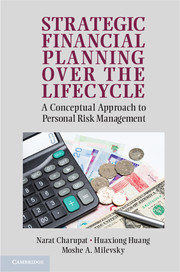Description
Strategic Financial Planning over the Lifecycle
A Conceptual Approach to Personal Risk Management
Authors: Charupat Narat, Huang Huaxiong, Milevsky Moshe A.
This is a final-year college level textbook on personal finance, jointly written by business school and mathematics professors.
Language: English
Subject for Strategic Financial Planning over the Lifecycle:
Approximative price 134.74 €
In Print (Delivery period: 14 days).
Add to cart
Strategic financial planning over the lifecycle: a conceptual approach to personal risk management
Publication date: 05-2012
382 p. · 15.2x22.9 cm · Hardback
Publication date: 05-2012
382 p. · 15.2x22.9 cm · Hardback
Approximative price 53.83 €
In Print (Delivery period: 14 days).
Add to cart
Strategic financial planning over the lifecycle: a conceptual approach to personal risk management
Publication date: 05-2012
382 p. · 15.2x22.6 cm · Paperback
Publication date: 05-2012
382 p. · 15.2x22.6 cm · Paperback
Description
/li>Contents
/li>Biography
/li>
This book on personal financial planning and wealth management employs the lifecycle model of financial economics. The central idea of 'consumption smoothing' is used to connect chapters and topics such as saving and investment, debt management, risk management and retirement planning. The first part of the book is nontechnical and aimed at a wide audience with no special technical background. The second part of the book provides a rigorous presentation of the lifecycle model from first principles using the calculus of variations. The accompanying website is found at http://www.yorku.ca/milevsky/?page_id=185.
1. Introduction and motivation; 2. Mathematical preliminaries - working with interest rates; 3. Personal balance sheet and human capital; 4. Consumption smoothing and optimal savings; 5. Debts, loans, and mortgages [Canadian content]; 6. Personal income taxes [Canadian content]; 7. Risk, utility, and insurance; 8. Mortality risk and life insurance; 9. Investment and diversification; 10. The mathematics of portfolio diversification; 11. Housing decisions; 12. Pensions and retirement [Canadian content]; 13. Advanced material*: Part I. Continuous time and the calculus of variations; 14. Advanced material*: Part II. Stochastic optimal control and the HJB equation; 15. Concluding thoughts and next steps.
Narat Charupat is an Associate Professor at the DeGroote School of Business, McMaster University, Ontario, Canada. His research has been published in journals such as the Journal of Economic Theory, the Journal of Banking and Finance, the Journal of Risk and Insurance and the Journal of Financial and Quantitative Analysis. Professor Charupat's areas of professional interest include annuity and insurance products, financial innovation, arbitrage and behavioral finance. He has taught courses in financial derivatives and personal and international finance.
Huaxiong Huang is a Professor of Applied Mathematics at York University, Toronto, Canada, where he has taught since 1999. He has published more than 60 articles in peer-reviewed journals including the Journal of Banking and Finance, Insurance: Mathematics and Economics, the Journal of Risk and Insurance and the Financial Analysts Journal. He is an associate editor of the Journal of Engineering Mathematics and Advances in Applied Mathematics and Mechanics and managing editor of the Mathematics-in-Industry Case Studies. A fellow of the Fields Institute, he has held visiting positions in China, Japan, the United Kingdom and the United States.
Moshe Milevsky is a Finance Professor at York University, Toronto, Canada, Executive Director of The IFID Centre in Toronto and President and CEO of the QWeMA Group. He has written eight books, more than 60 peer-reviewed journal articles and more than 200 articles in the popular press on insurance, investments, pensions, retirement and annuities, including The Calculus of Retirement Income: Financial Models for Pension Annuities and Life Insurance (Cambridge University Press, 2006). A fellow of the Fields Institute, Professor Milevsky has received two National Magazine (Canada) awards, the Graham and Dodd scroll award and been honored by the Retirement Income Insurance Association for lifetime achievement in applied research. In 2009, Investment Adviser magazine named him on
Huaxiong Huang is a Professor of Applied Mathematics at York University, Toronto, Canada, where he has taught since 1999. He has published more than 60 articles in peer-reviewed journals including the Journal of Banking and Finance, Insurance: Mathematics and Economics, the Journal of Risk and Insurance and the Financial Analysts Journal. He is an associate editor of the Journal of Engineering Mathematics and Advances in Applied Mathematics and Mechanics and managing editor of the Mathematics-in-Industry Case Studies. A fellow of the Fields Institute, he has held visiting positions in China, Japan, the United Kingdom and the United States.
Moshe Milevsky is a Finance Professor at York University, Toronto, Canada, Executive Director of The IFID Centre in Toronto and President and CEO of the QWeMA Group. He has written eight books, more than 60 peer-reviewed journal articles and more than 200 articles in the popular press on insurance, investments, pensions, retirement and annuities, including The Calculus of Retirement Income: Financial Models for Pension Annuities and Life Insurance (Cambridge University Press, 2006). A fellow of the Fields Institute, Professor Milevsky has received two National Magazine (Canada) awards, the Graham and Dodd scroll award and been honored by the Retirement Income Insurance Association for lifetime achievement in applied research. In 2009, Investment Adviser magazine named him on
© 2024 LAVOISIER S.A.S.



